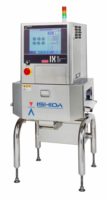Flood packaging reflects the evolving history of mankind. From the days when the “kill” was thrown on a back to return to the campfire, to the dried foods of explorers in the seventeenth and eighteenth centuries, to today’s fresh packs, food packaging has paralleled, and in part driven, civilization’s expansion and increased longevity. The early nineteenth century saw the birth of canning when Nicholas Appert, a Parisian, successfully preserved food by partially cooking it, sealing it in bottles with cork stoppers, and immersing the bottles in boiling water. For his efforts, Napoleon awarded him 12,000 francs (about $1,600 today) in 1810. After work by other entrepreneurs, the British Royal Navy was stocking canned foods on ships as early as 1818.
Ever since the word “plastic” was spoken in the 1960s film, “The Graduate,” another revolution has been occurring in the food packaging industry. But with new technology comes new challenges, especially with the variety of foods and package interfaces now possible. Today, a major concern is whether any packaging component will migrate into food, or whether flavors, colors or ingredients will be scalped into packaging material.
Food safety and marketing professionals both have concerns about the safety of the packaged food, as well as the appearance, flavor, odor and other factors affecting consumer appeal. However, while consumer appeal issues will determine the success or failure of a given product, an unsafe container is a public health issue and will affect the future of a food or packaging manufacturer. Because food adulteration violates federal law, food safety professionals should also consider the risk of package component migration and be aware of regulations governing this area.
Watching the Regulations
Food safety professionals must first answer whether the desired packaging material has been cleared by the U.S. Food and Drug Administration (FDA) for contact with food. If the answer is “Yes,” your job is much simpler. First, you’ll need to satisfy yourself that you’re in compliance with FDA regulations. This applies to any packaging component which may affect food quality—not just the container, but also the printing inks, labels and seals. Packagers should insist that their packaging material suppliers demonstrate compliance via a letter or other documentation. Some testing is advisable as a quality check to ensure that embarrassing questions won’t be raised down the road. Then you’re ready to package.
Now, let’s look at how regulations apply to food safety. Title 21 (Food and Drugs) of the Code of Federal Regulations addresses this issue. Every food packaging professional should have Parts 170 to 199 of this regulation, which lists substances cleared for food contact use. These lists are grouped into parts (chapters) according to material type, such as adhesives and coatings (Part 175); paper and paperboard components (Part 176); and polymers (Part 177). In each part, material specifications are tabulated. By reading the fine print, you can determine whether your packaging material is listed. If it is, you’re free to use it under the use conditions summarized.
One or more extraction or solubility tests are then described in detail. These are the tests that a laboratory should use to ensure that a supplier is delivering compliant material. Depending on the food type to be packaged and the temperature at which it will be used, the packaging material is heated in a solvent for a specified time and temperature. The solvent is then analyzed for extracted components. This simulates the most extreme conditions to which the packaging will be subjected. Your goal is to ensure that harmful compounds aren’t extracted into the food under actual use.
Because solvents present fewer problems in the analytical laboratory, they’re generally used in food package extraction testing instead of actual foods. The term food- simulating solvent is used, since the solvents simulate the action of foods on packaging. For example, dilute aqueous ethanol simulates the action of aqueous, acidic or low-alcohol foods while heptane is used for fatty foods.
To find detailed test conditions, you must know the food type to be packaged and the most extreme heat conditions to which it will be subjected. The FDA classifies foods into nine types, depending on the amount of acid, alcohol, or fat they contain. These types, labeled 1—IX, are frilly defined in 21 CFR Part 176.170. Temperature conditions are divided into the so-called “Conditions of Use,” also defined in the CFR. These include high temperature, heat sterilized use (over 212°F), hot filled or pasteurized use (above or below 150°F), and room temperature, refrigerated or frozen use. Understanding your Food Type and Condition of Use enables you to choose the proper extraction test conditions.
What does the laboratory do with the extracts? Since many specifications are based on the amount of nonvolatile residue extracted by the food-simulating solvent, the solvent may simply be evaporated and the residue weighed. Results are generally expressed in milligrams of residue extracted per square inch of packaging surface area. Some specifications require ensuring that the ultraviolet absorption of the extract is below a given value while others detail the solubility in dilute hydrochloric acid or the maximum extractable fraction in solvents such as benzene, ethyl acetate or chloroform.
Food Contact Notification
Now, what if a component of a packaging material isn’t listed in the CFR? What do you do then? Perhaps a pigment manufacturer wants to market his bright yellow pigment for use in beverage bottles. 21 CFR 178.3297 lists all approved colorants for polymers. If the yellow pigment isn’t listed, it’s not approved, and it can’t be used until it is. Or maybe a new resin is available for making these bottles. Only the polymers listed in 21 CFR 177 can be used in food contact applications unless FDA approval is obtained. In order to get approval the producer has to jump through a set of hoops called Food Contact Notification (FCN).
Prior to January 2000, FDA clearance of a new food-contact material required the preparation of a Food Additive Petition or a Threshold of Regulation request. These were expensive procedures that sometimes took years to clear the FDA. But since early 2000, the new FCN procedure has streamlined the clearance process considerably. Among other things, the notifier presents data to the FDA on the potential migration of the component into foods. If the FDA does not object within 120 days to the use of the substance, based on safety grounds, it may be marketed immediately.
What kind of migration data is needed? It’s related to the Food Type and the Condition of Use. For ease of analysis, food-simulating solvents are generally used instead of actual foods. For example, migration into aqueous, acidic and low-alcohol foods is generally evaluated using 10% ethanol. Migration into fatty food frequently requires evaluation with a food oil. Heptane, used in CFR testing, may overestimate migration and is generally avoided. Miglyol, a fractionated coconut oil, is often used to satisfy FDA requirements while the European countries require olive oil. Analyzing for packaging migrants in food oil can present formidable analytical difficulties, so 50% or 95% ethanol sometimes can be substituted.
Tests must be performed in triplicate. The test material is immersed in the solvent and heated using a given temperature which depends on the Condition of Use. For example, the most extreme condition requires heating at 250°F for two hours, followed by 10 days at 104°F. Since this is above the boiling point of most food-simulating solvents, special cells are used, which are designed to withstand the extremes of temperature and pressure encountered. Some cells are constructed so that only glass and Teflon contact the solvent, while others may be all stainless steel. The cells are also configured so that all surfaces of the test material can contact the solvent or, in the case of a coating, only one side of a test plaque will be extracted.
For safety, cells are then placed in a high-pressure vessel for heating. The National Food Laboratory (The NFL) uses a steam retort in our pilot plant, which over-pressures the cells, which prevents leaking. At various intervals during the testing period, the solvent is sampled and the migrating component analyzed. Not surprisingly, one prefers to find no migration. This is the simplest regulatory situation. However, if migration is found, the safety of the migrant must be evaluated, taking into consideration the amount found and other factors discussed below.
Analytical chemists trained in the use of gas chromatography (CC), high-performance liquid chromatography (HPLC) and mass spectrometry (MS) often apply these techniques to analyzing extracts. For example, when the packaging material contains a metal which may migrate in a new colorant, the laboratory will need atomic absorption (AA) spectrometry or inductively coupled plasma (ICP) spectrometry. Each analytical method must be capable of reaching the required detection limit, typically 50 parts per billion (ppb) or less. A well-equipped laboratory can choose the proper analytical technique to solve any analytical problem, which may, and frequently does, arise during migration testing.
The FDA won’t take the word of the analytical laboratory that the methodology used is suitable and capable of delivering the correct result. Food Contact Notification regulation requires that each analytical method be validated. Extracts of samples or controls must be spiked with the potential migrant at known levels, then analyzed using the same method as used for the sample extracts. Adequate recovery of the spiked material shows that the method works as reported.
Migration data developed using the procedures discussed above are intended to provide estimates of the highest level of migration to food that might result from the anticipated use of the food contact substance. These data, when combined with the consumption factor (CF) and food-type distribution (fT) indicate consumer exposure to the food contact substance. The CF is the fraction of packaged food that is packaged in the material tested and r is the fraction of packaged food contacting the major food types. Some of these factors are published by FDA (http://vm.cfsan.fda. gov/~dms/opa-pmnc.html). The tables show, for example, that a CF of 0.10 for polystyrene means that l0% of packaged food is packaged in polystyrene. Additionally, an fT of 0.67 for polystyrene indicates that 67% of this material is used for packaging aqueous foods. By appropriately combining these factors with the migration data, consumer exposure can be calculated.
FCN can be a time-consuming process. What if a producer goes through all this trouble only to find the migration rate is too great? The packaging material will have to be reformulated and retested—requiring more time and money. The laboratory can help design exploratory tests to point the developer of a food contact substance in the right direction and lessen the risk that a costly migration study will have to be repeated.
Common Migration Problems
The following packaging migration issues are a few recently encountered by The NFL. Food manufacturers and others should be aware of these as potential or newly identified migration problems when using or considering using these types of packaging:
• Plastic Films. Packagers of fresh vegetables and fruits need assurance that packaging will not adulterate their products. Recently, Grimmway Farms in Bakersfield, California required documentation that each of their plastic packaging film suppliers remained compliant with 21 CFR 175.300. Since this grower packages its carrots for the fresh produce market, the packaging is vital in assuring a quality product. Patrick Kelly, Director of Quality Assurance, initiated a monitoring program in order to verify that the carrots were not adulterated by packaging components.
• Modified Atmosphere Packaging (MAP). Food companies continue to ask if they should be concerned about potential migration problems with modified or controlled atmosphere packaging. In order for this concept to be effective, plastics must be properly chosen for their gas and moisture permeation properties. But from a migration standpoint, there are no special regulatory concerns. That is, these materials must be FDA compliant as must all packaging materials.
• VOCs. An area of concern to food safety professionals which has arisen in recent years is the emission of volatile organic compounds (VOCs) from food packaging during microwave cooking. In this cooking process, the packaging is heated together in the presence of the food. Organic compounds, some carcinogenic like benzene or vinyl chloride, can be emitted by the packaging which in turn may be absorbed by the food in contact or merely in proximity to the packaging. This can be an issue not only with foods heated to a high temperature, such a microwavable popcorn, but also with frozen foods heated in trays. The presence of printing on the package is especially problematical as inks are formulated with volatile solvents.
Concentrations are generally expressed in micrograms of volatile per square inch of packaging. There are no specific emission limits regulated by the FDA. However, food packagers are required by law to use food contact materials which are sufficiently pure for the intended use. That is, they must not adulterate the food.
• Antimicrobial Substances in Packaging. Antimicrobials may be formulated within the packaging itself or may be used on surfaces which come in contact with food. The former case is a new concept of great interest to food safety professionals. All of the concepts outlined above still apply. That is, a Food Contact Notification must be prepared and submitted to the FDA for all packaging substances not previously cleared for food contact use. However, since the U.S. Environmental Protection Agency (EPA) also regulates antimicrobials as pesticides, these materials may also require registration with the EPA under the Federal Insecticide, Fungicide, and Rodenticide Act (FIFRA). This has created a confusing dual jurisdiction between the FDA and the EPA which has yet to be resolved.
Sanitizers and other cleaners used to treat food processing equipment and some packaging may also find their way into food products. While not strictly migration problems, such cases frequently lead to customer complaints. Recently, a producer of frozen bakery products began receiving complaints about a strange, chemical taste in one of its products. Analysis of the high- fat frosting which was in direct contact with the coated paper package revealed the presence of adulterants, possibly sanitizers, which had migrated from the packaging material. Another complaint based on a pine-like or citrus odor in a canned dry tea was linked to improper cleaning of the cans prior to packaging.
• Irradiation. One of the newest food treatment procedures is irradiation. Today, there are no FDA regulations regarding the testing of food packaging following gamma or electron beam irradiation, but the law requires that packaging not adulterate food. Therefore, The NFL has been working with clients to design and implement testing protocols to demonstrate whether materials produced during irradiation migrate into food. Generally, this involves irradiating packaging in contact with food-simulating solvents, then carefully examining the solvents for any packaging breakdown products. This can be a tedious process since these breakdown products are often unknown. The analyst must look for differences between irradiated and non-irradiated samples, then identify and quantify the differences. CC/MS is an excellent technique for this work.
• International Regulations. Processors should be aware that in order to export products, they will have to comply with the food packaging regulations in the country where their products are sold. A vegetable canner recently requested that The NFL analyze its can coatings to ensure compliance with Japanese regulations. Extensive testing was required to ensure that metals (lead and cadmium), certain organic impurities (phenol, formaldehyde and vinyl chloride) and total nonvolatile residues were not above their regulatory limits. These regulations were sufficiently different from the related FDA regulations to require separate extraction and analyses just to satisfy requirements for the Japanese market.
Conclusion
As consumers search for better tasting, low-preparation foods, the food industry will continue to develop packaging, ingredient and processing options. With this proliferation of options comes the challenge of keeping up with factors affecting the safety of your products. That’s why it’s essential to identify and establish relationships with packaging experts who can guide you through the ever-changing minefield of regulations and testing technology, so you stay competitive with safe, novel products.
Robert Bussey, Ph.D., is Project Manager, Regulatory Services with responsibilities for food package testing and pesticide analysis at The National Food Laboratory in Dublin, CA. He has more than 25 years experience in analysis of trace impurities in food, water and other materials. His areas of specialty include the application of DC, HPLC, DC/MS and atomic absorption spectrometry to the analysis of packaging raw materials and finished packaging including plastics and coated paper.
>




